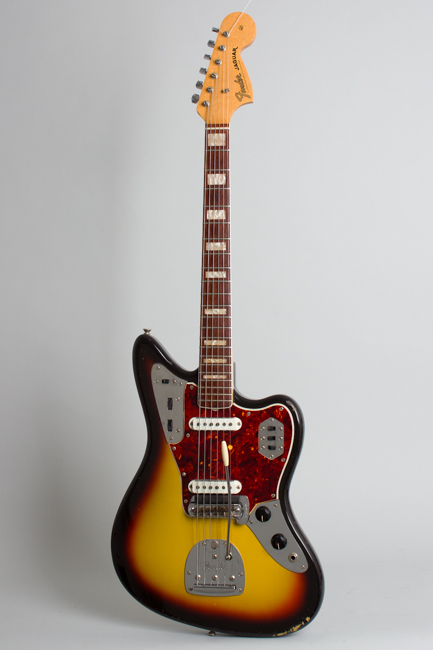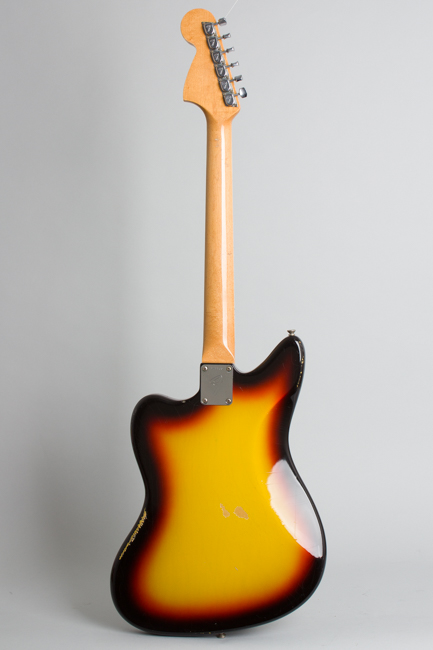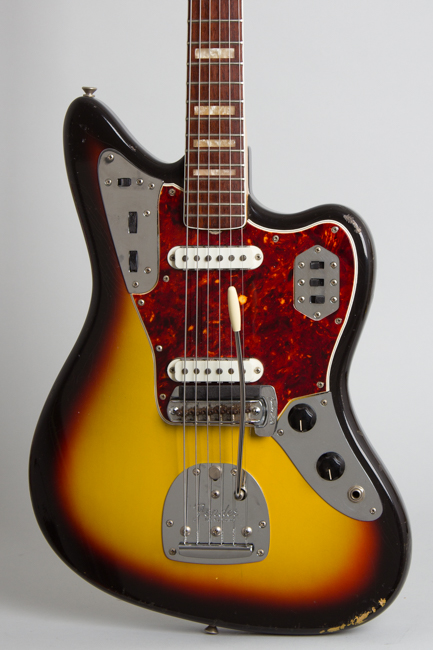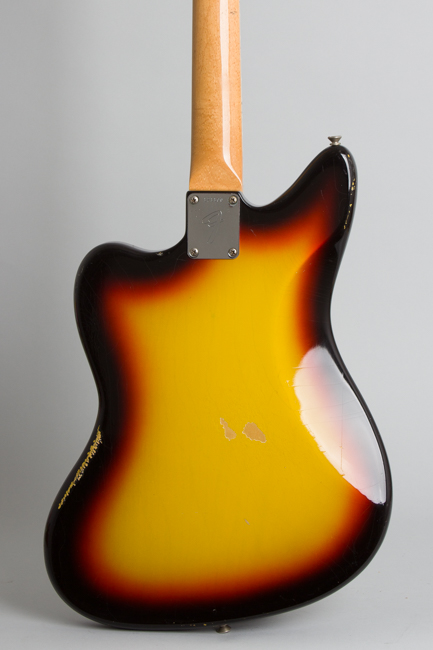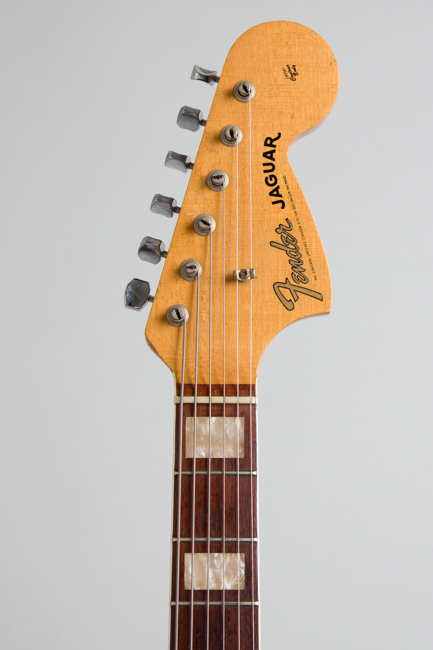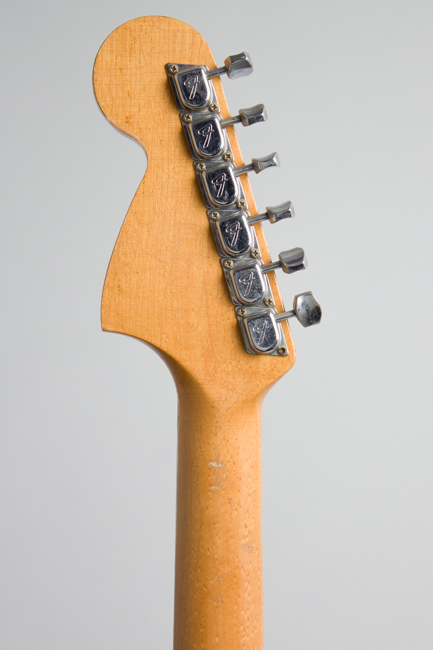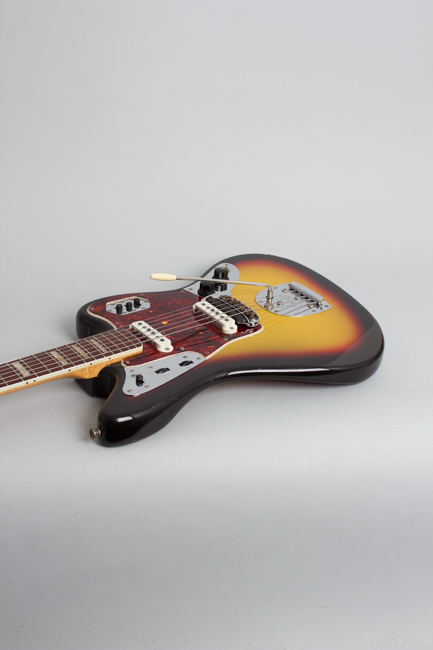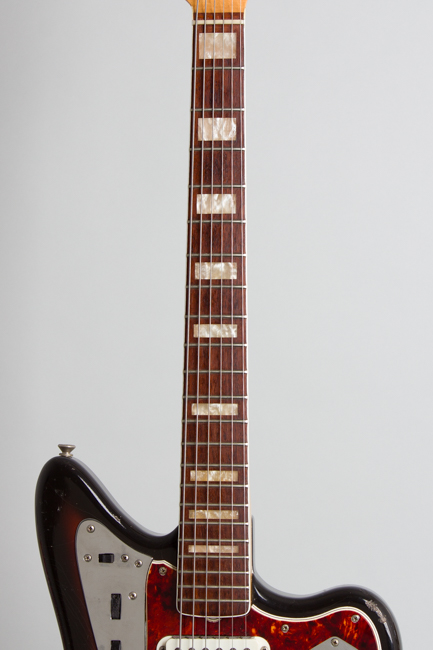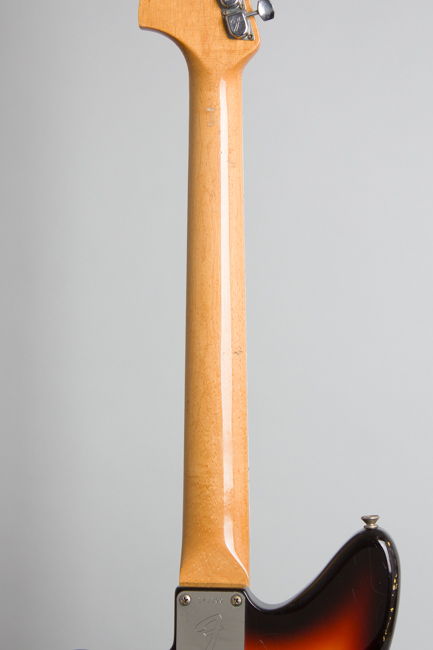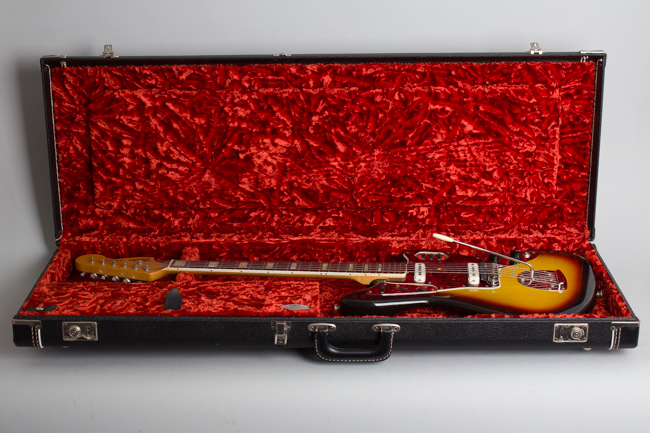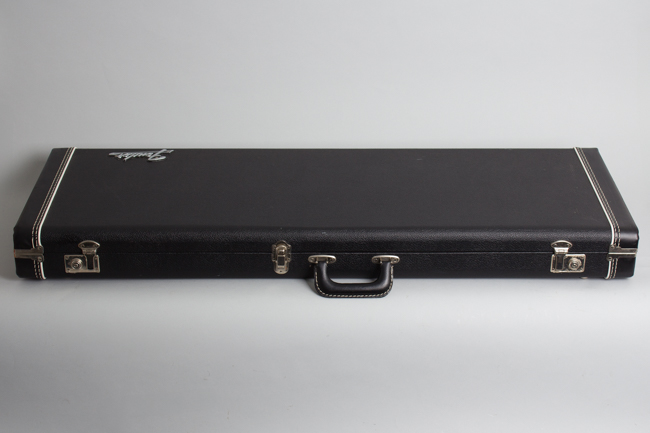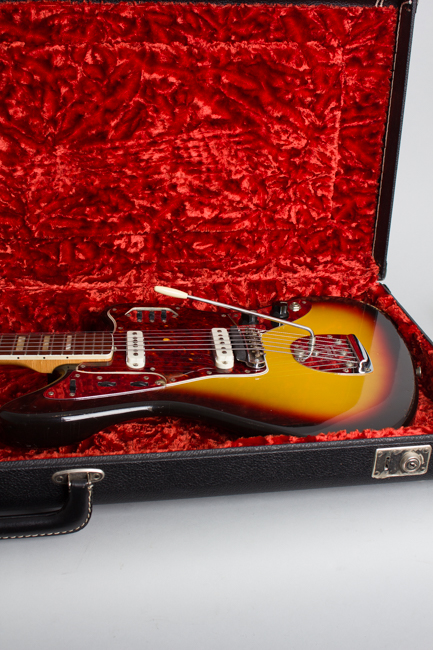Fender Jaguar Solid Body Electric Guitar (1966)
Fender Jaguar Model Solid Body Electric Guitar (1966), made in Fullerton, California, serial # 171100, sunburst lacquer finish, alder body, maple neck with rosewood fingerboard, black tolex hard shell case.
This early-CBS-era Jaguar shows only some moderate wear for its nearly 60 years on the planet and remains overall in nicely original condition. This instrument was the top-of-the-line Fender guitar in 1966, although the model's popularity was beginning to fade around this time. This guitar was built not quite two years after the Fender sell-out to CBS in January 1965, but has some noticeable changes from a Pre-CBS example.
The pots on this guitar date to the 12th week of that 1966. The most notable change from earlier models is the is the bound fingerboard with pearloid block inlay, a recent "upgrade" at this time. The old style lacquer finish is still on the body and neck, just applied a bit thicker than the Pre-CBS era. Other features include the gold transition logo headstock decal, newer "F" housing tuners and pickguard made of tortoise pattern plastic instead of the nitrocellulose used earlier.
Even having undergone a noticeable revival in recent years, the Jaguar remains a somewhat under-appreciated guitar with several interesting features. The 24" scale length is shorter than other professional-grade Fender guitars, a feature designed to enhance playability. The twin-circuit wiring and floating vibrato are shared with the Jaguar's ancestor the Jazzmaster, but the guitar actually feels and sounds quite different.
The unique Jaguar pickups with the metal "claw" baseplate are optimized for clarity and crispness, factors that led to the guitar losing popularity in the late '60s as twang went out and distortion and crunch came in! It also performs better with heavier strings, due to the combination of a short scale and the low tension vibrato system. Nevertheless, this was the top-of-the line Fender and a very high quality guitar, a flashy chrome-trimmed California hot rod.
Overall length is 40 in. (101.6 cm.), 14 in. (35.6 cm.) wide at lower bout, and 2 in. (5.1 cm.) in depth, measured at side of rim. Scale length is 24 in. (610 mm.). Width of nut is 1 5/8 in. (41 mm.).
This is a relatively clean and all original guitar, showing some general wear but no serious alteration or repair. The original lacquer finish has hardly any fade but some light checking a decent number of random dings, dents and chips, many of which are along the rim. This wear is heaviest along the back and lower edges of the body, and a number of spots have been discreetly touched up. The heaviest chips are along the back edge of the body, with a patch of belt buckle wear through the finish on the back as well.
The neck finish shows a few isolated dinks and dents, the deepest a couple of feelable dings into the wood around the first fret zone. Although showing some pretty random wear the guitar does not appear to have been played all that much over the last 59 years; it does appear to have been rather casually handled at tome point. The original small frets show very little wear and the guitar still plays well.
The hardware mostly original; exceptions are the trem arm which is a correct repro, and one switch has been replaced but the original is in the case. The flip-up mute is intact and functional with newly replaced foam, if there are any players out there that want to use this feature! The case is a G&G repro of a period Fender HSC. This Jaguar is a solid example of CBS/Fender's sleek chromed 1960's hot rod from the time right before the model started to fall from favor; a trend now completely reversed! Excellent - Condition.
This early-CBS-era Jaguar shows only some moderate wear for its nearly 60 years on the planet and remains overall in nicely original condition. This instrument was the top-of-the-line Fender guitar in 1966, although the model's popularity was beginning to fade around this time. This guitar was built not quite two years after the Fender sell-out to CBS in January 1965, but has some noticeable changes from a Pre-CBS example.
The pots on this guitar date to the 12th week of that 1966. The most notable change from earlier models is the is the bound fingerboard with pearloid block inlay, a recent "upgrade" at this time. The old style lacquer finish is still on the body and neck, just applied a bit thicker than the Pre-CBS era. Other features include the gold transition logo headstock decal, newer "F" housing tuners and pickguard made of tortoise pattern plastic instead of the nitrocellulose used earlier.
Even having undergone a noticeable revival in recent years, the Jaguar remains a somewhat under-appreciated guitar with several interesting features. The 24" scale length is shorter than other professional-grade Fender guitars, a feature designed to enhance playability. The twin-circuit wiring and floating vibrato are shared with the Jaguar's ancestor the Jazzmaster, but the guitar actually feels and sounds quite different.
The unique Jaguar pickups with the metal "claw" baseplate are optimized for clarity and crispness, factors that led to the guitar losing popularity in the late '60s as twang went out and distortion and crunch came in! It also performs better with heavier strings, due to the combination of a short scale and the low tension vibrato system. Nevertheless, this was the top-of-the line Fender and a very high quality guitar, a flashy chrome-trimmed California hot rod.
Overall length is 40 in. (101.6 cm.), 14 in. (35.6 cm.) wide at lower bout, and 2 in. (5.1 cm.) in depth, measured at side of rim. Scale length is 24 in. (610 mm.). Width of nut is 1 5/8 in. (41 mm.).
This is a relatively clean and all original guitar, showing some general wear but no serious alteration or repair. The original lacquer finish has hardly any fade but some light checking a decent number of random dings, dents and chips, many of which are along the rim. This wear is heaviest along the back and lower edges of the body, and a number of spots have been discreetly touched up. The heaviest chips are along the back edge of the body, with a patch of belt buckle wear through the finish on the back as well.
The neck finish shows a few isolated dinks and dents, the deepest a couple of feelable dings into the wood around the first fret zone. Although showing some pretty random wear the guitar does not appear to have been played all that much over the last 59 years; it does appear to have been rather casually handled at tome point. The original small frets show very little wear and the guitar still plays well.
The hardware mostly original; exceptions are the trem arm which is a correct repro, and one switch has been replaced but the original is in the case. The flip-up mute is intact and functional with newly replaced foam, if there are any players out there that want to use this feature! The case is a G&G repro of a period Fender HSC. This Jaguar is a solid example of CBS/Fender's sleek chromed 1960's hot rod from the time right before the model started to fall from favor; a trend now completely reversed! Excellent - Condition.
